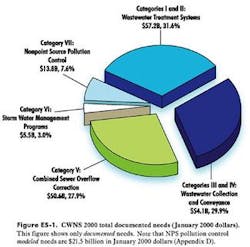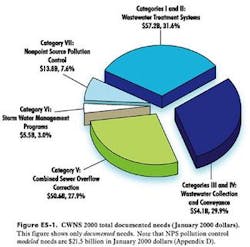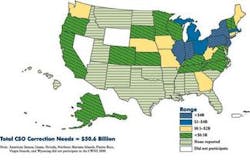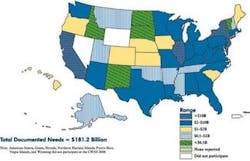Clean Watersheds Needs Survey Reveals $181 Billion in Needs
The US wastewater market needs to spend $181.2 billion on water quality programs and projects eligible for funding under the Clean Water State Revolving Fund (CWSRF), according to a report released by the Environmental Protection Agency.
The agency recently submitted its Clean Watersheds Needs Survey 2000 Report to Congress. The "needs" covered in the CWNS 2000 report reflect an increase of $26.6 billion (17.2 percent) from the previous Clean Water Needs Survey, completed in 1996.
Total needs are presented for wastewater treatment, collection, and conveyance; CSO correction; storm water management programs; and NPS pollution control.
The EPA report was compiled to meet the requirements set forth in section 516 of the Clean Water Act (CWA). Because of water quality problems associated with nonpoint source (NPS) pollution, EPA elected to include NPS pollution control projects as well.
The Clean Watersheds Needs Survey (CWNS) 2000 is a collaborative effort between 48 States, the District of Columbia and EPA. States entered data into the CWNS database over a 21-month period to be evaluated and analyzed by EPA.
The name of the survey was recently changed from the Clean Water Needs Survey to the Clean Watersheds Needs Survey to recognize the increasing number of water pollution control activities, such as developing Total Maximum Daily Loads (TMDLs) and setting certain Safe Drinking Water Act objectives, that are managed on a watershed basis.
The report presents the capital costs for publicly owned municipal wastewater collection and treatment, combined sewer overflow (CSO) correction, municipal storm water management, and NPS pollution control.
The report presents the cost data in the CWNS database as "needs." A "need" is defined as a water quality or public health problem and an associated abatement cost that is eligible for funding under the CWSRF. The needs must have existed as of January 1, 2000, to be included in the CWNS 2000.
The CWNS 2000 Report to Congress presents the total needs estimates in two ways. The first method is based entirely on documented needs. These documented needs are entered by a state and validated by appropriate documentation. This is the first time, since the beginning of the CWNS, that the report to Congress presents only the documented total need for the nation. In past surveys, EPA modeled needs data to supplement the survey results.
For this report EPA believes that the data entered into the CWNS adequately represent the nation's needs for wastewater treatment and collection.
For diffuse sources of pollution (such as nonpoint sources, sanitary sewer overflows [SSOs], and municipal storm water), however, data limitations preclude complete reliance on a documented needs approach. Therefore, the report includes a modeled national needs estimate for these diffuse sources.
Improved data quality and integrity was a primary objective that both EPA and the states strove to meet when documenting all needs in the CWNS 2000; however, collecting documentation and needs data for NPS pollution control, SSOs, CSOs, and storm water was a particular focus for this survey.
In keeping with the objective of improving data quality, states were required to redocument certain needs remaining from previous surveys. The CWNS National Workgroup initiated this effort with the 1996 Clean Water Needs Survey, and it proved to be successful in eliminating needs in the database that had already been met.
Another important objective was the requirement that every facility in the CWNS 2000 include geographic information. This objective was important for helping states and EPA use data in the CWNS 2000 database for other initiatives beyond the report to Congress.
Wastewater Treatment, Collection, Conveyance
The needs for wastewater treatment are $57.2 billion, or 31.6 percent of the total needs. Eligible wastewater treatment needs include the capital costs of replacement, rehabilitation, expansion, upgrade, or process improvement of treatment plants; construction of new treatment plants; and construction, replacement, or rehabilitation of individual on-site systems and decentralized systems.
Of the $57.2 billion wastewater treatment needs, only $32.7 billion are new wastewater treatment needs identified for the first time during the CWNS 2000 data collection period.
Needs for wastewater collection and conveyance account for $54.1 billion, or 29.9 percent of the total needs. Needs include capital costs for replacement, rehabilitation, or expansion of existing collection systems, as well as construction of new collection systems. These needs represent an $18.8 billion (53.3 percent) increase from the previous survey.
The $4.5 billion increase for infiltration/inflow (I/I) correction and $9.1 billion increase for sewer replacement and rehabilitation since the previous survey suggest that communities are beginning to plan for substantial capital renewal projects that indicate aging infrastructure.
CSO Correction
The estimated cost to control CSOs is $50.6 billion, an increase of $1 billion from the amount shown in the 1996 Clean Water Needs Survey.
The $50.6 billion estimate is primarily based on the level of control presented under the "Presumption Approach" in the 1994 CSO Control Policy. That level of control is based on capturing 85 percent of the flows that enter the combined sewer system during wet weather events and providing those flows with the equivalent of primary clarification, solids and floatables disposal, and disinfection of the effluent.
Storm Water Management Programs
Nineteen states and the District of Columbia reported $5.5 billion (3 percent of total needs) in documented storm water management program needs. Despite the increased availability of storm water management program information, not all states submitted storm water management needs. As a result, the storm water control needs presented in EPA's report underestimate the nation's storm water management program needs.
Storm water needs include the capital costs for developing and implementing municipal storm water management programs to meet the requirements of Phases I and II of the National Pollutant Discharge Elimination System (NPDES) storm water regulations.
Because the storm water Phase II regulations were finalized on December 8, 1999, and did not take effect until March 2003, municipalities with Phase II needs identified as of January 1, 2000, were allowed to have their projected needs entered into the CWNS 2000 database.
Nonpoint Source Pollution Control
The needs eligible for inclusion under Nonpoint Source Pollution Control include those associated with implementing NPS management programs under section 319 of the CWA, as well as developing and implementing Comprehensive Conservation and Management Plans (CCMPs) for estuaries under section 320 of the CWA.
Thirty-two states and the District of Columbia documented needs totaling $13.8 billion (7.6 percent of total needs) for NPS pollution control.
Urban and hydromodification NPS pollution control needs account for the largest portion of the total NPS pollution control needs.
Unable to identify all sources of NPS pollution, many states have not developed or identified documentation for CWNS 2000 that represents all of their NPS needs.
EPA has provided a separate modeled estimate for some categories of NPS needs. Certain subcategories of NPS needs (Ground Water, Brownfields, Storage Tanks, and Sanitary Landfills) were not modeled because of a lack of data. For the categories modeled, the full array of best management practices and behavioral changes were not accounted for because of data and time restraints.
Neither the documented estimate nor the modeled estimate gives a complete picture of NPS needs. It is inappropriate to add the modeled needs to the documented needs estimate because of the overlap between the two.
Small Community Needs
In addition to the needs documented in the CWNS 2000 for established need categories, the survey also had the ability to estimate the needs for small communities. Small communities, defined as communities with a population of fewer than 10,000 people and an average daily wastewater flow of less than 1 million gallons, have documented needs of approximately $16 billion, representing about 10 percent of the $161.9 billion in documented wastewater treatment and collection system needs for the country. For small communities, the needs for wastewater treatment are $4.8 billion. Collection and conveyance needs are $9.4 billion, and CSO correction needs $1.9 billion.
Sanitary Sewer Overflows
SSOs can be caused by many factors, including peak flows that exceed system capacity; blockages; structural, mechanical, or electrical failure; and third-party actions or activities. In this report and in previous reports to Congress, some portion of the documented needs for I/I correction, sewer replacement/rehabilitation, new relief sewers, and increased treatment plant capacity can be attributed to SSO correction.
During the CWNS 2000, 27 States identified 775 facilities with SSO problems. EPA used a model to estimate the capital costs associated with wet weather SSO correction. The model is based on reducing wet weather overflows to no more than one in a collection system every 5 years.
Data (e.g., population, flow) for the model were obtained from the CWNS 2000 database. The modeled estimate is $88.5 billion. The modeled estimate should not be added to the CWNS 2000 documented needs because the needs from various other categories might already include costs to address SSOs.
Watershed Management
The needs in the CWNS are presented on a State-by-State basis, reflecting the responsibility that States have in achieving water quality standards and other CWA goals. Recently, however, substantial emphasis has been placed on using the watershed approach to address the water quality goals of the CWA more holistically. This is particularly the case as States continue to develop TMDLs for impaired waters that must integrate point and nonpoint source pollutant loading controls.
Rather than managing sources of pollution within political boundaries or from a single type of discharge, watershed management provides a more comprehensive perspective for both analysis and efficient use of resources.
EPA and the States have made a concerted effort in the CWNS 2000 to gather information on a watershed basis, which is consistent with EPA's watershed management approach. In Chapter 5 of EPA's report, a national watershed analyses and a case study from the Long Island Sound are presented to illustrate the potential of the CWNS to organize needs information by watershed.



